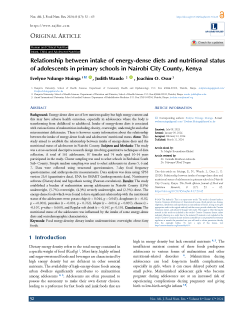Relationship between intake of energy-dense diets and nutritional status of adolescents in primary schools in Nairobi City County, Kenya
Abstract
Background: Energy-dense diets are of low nutrient quality but high energy content and this may have adverse health outcomes, especially in adolescence where the body is transforming from childhood to adulthood. Intake of energy-dense diets is associated with various forms of malnutrition including obesity, overweight, underweight and other micronutrient deficiencies. There is however scanty information about the relationship between the intake of energy-dense foods and adolescents' nutritional status. Aims: This study aimed to establish the relationship between intake of energy-dense diets and the nutritional status of adolescents in Nairobi County. Subjects and Methods: The study was a cross-sectional descriptive research design involving quantitative techniques of data collection. A total of 161 adolescents, 87 females and 74 male aged 10-14 years participated in the study. Cluster sampling was used to select schools in Embakasi South Sub- County. Simple random sampling was used to select adolescents in classes 5, 6 and 7. Data were collected using structured questionnaires, 7-day food frequency questionnaires, and anthropometric measurements. Data analysis was done using; SPSS version 23.0 (quantitative data), ENA for SMART (anthropometric data), Nutrisurvey software (Dietary data) and hypothesis testing (Pearson correlation). Results: The study established a burden of malnutrition among adolescents in Nairobi County (13%) underweight, (5.7%) overweight, (4.3%) severely underweight, and (2.5%) obese. The energy-dense foods which were found to have significant relationship with the nutritional status of the adolescents were: potato chips (r = 0.044, p = 0.045), doughnuts (r = -0.02, p = <0.001), pancakes (r = -0.001, p = 0.762), bhajia (r = -0.014, p = 0.897), cheese (r = -0.107, p-value = 0.660), and Regular soft drink (r = -0.147, p= 0.101. Conclusion: The nutritional status of the adolescents was influenced by the intake of some energy-dense diets and sociodemographic characteristics.
Keywords: Food energy-density; dietary intake; undernutrition; overweight; obese; fatty foods.
Full text article
Authors
Copyright (c) 2024 Evelyne Muinga, Judith Waudo, Joachim Osur

This work is licensed under a Creative Commons Attribution 4.0 International License.
-
Attribution — You must give appropriate credit, provide a link to the license, and indicate if changes were made. You may do so in any reasonable manner, but not in any way that suggests the licensor endorses you or your use.
-
No additional restrictions — You may not apply legal terms or technological measures that legally restrict others from doing anything the license permits.





